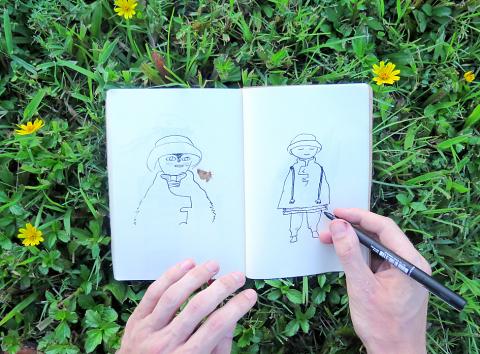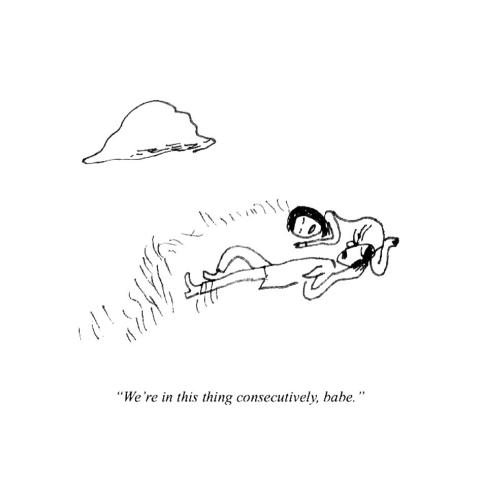Jameson Zimmer is the sort of person who finds wonder in simplicity and whimsy in the ordinary. When I tell him I grew up in the mountains of Yangmingshan (陽明山) in northern Taipei, he says it must have been “magical” — when what stands out the most in my memory, by contrast, is having to kill snakes and spiders that frequently crawled from the nearby forest into my room.
The Virginia native who currently works part-time as an instructor at Camp Taiwan, a nature camp for children in Yangmingshan, spends the rest of his time eking out a living creating cute comics, Internet art and zines. He’s also the author of the forthcoming illustrated children’s book, Bedtime in Yangmingshan.
Raised on a farm in rural Virginia by a printmaker mother and dairy herdsman father, Zimmer found his way to Taipei by fluke. After studying creative writing in college, he worked in outdoor recreation leading bicycle tours and organizing backpacking trips. Wanting to travel more, he searched for opportunities to continue working with children outdoors — and Taiwan was one of the few places outside of the US to offer that.

Photo courtesy of Moonie Tyler
Zimmer says the main themes in his art and writing are nature, childhood and melancholy. As he soon discovered, Taipei’s blend of laidback metropolitanism, combined with its unpretentious art scene and easy access to nature, would provide the perfect setting for him to hone his craft.
“The city has a quiet and refined sensibility that’s really appealing to someone who would rather spend time doing creative things at a co-working space than getting drunk at a bar,” Zimmer says.
That being said, he says he has spent countless nights pouring over art and design books in the Dunhua Eslite Bookstore (誠品) — which is open 24 hours a day — where he finds inspiration from the minimalistic graphic style of local designers such as Nieh Yung-chen (聶永真) and Wang Chih-hung (王志弘). Sharing the space with other “insomniac introverts” gave him encouragement that there were opportunities for dreamy, creative types to do well in the city.

Photo courtesy of Moonie Tyler
He adds that it’s “very cool to see people making a living screen-printing, embroidering, making zines and generally doing awesome stuff.”
SWEATY ROCKS
Zimmer’s drawings and writings dabble in light-hearted humor. His style, like his personality, is charming and whimsical rather than lofty or sarcastic. He uses phrases such as “clattering palm leaves” and “creepy bamboo thickets,” and sketches cutesy-looking comics with black ink or watercolors.

Photo courtesy of Moonie Tyler
“People definitely respond well to a light-hearted drawing style, especially here,” he says.
Despite his humble demeanor, Zimmer has managed to hone in on what makes Taiwanese audiences tick — and this shows in the characters he creates for the popular messaging app Line.
He initially started with inventing his own animated GIFs for chatting with friends in China on WeChat (a messaging app used in China) and decided one day to submit some ideas to Line.
“It’s just a question of figuring out the sort of aesthetic they like, adhering to their guidelines and waiting months on end for them to look at your designs,” Zimmer says.
Featuring two little stones in a symbiotic love-hate relationship, Sweaty Rock — Zimmer’s latest set that he’s working on for Line — is largely a commentary on his impressions of Taiwanese couple culture, notably the ups, the downs and all the hilarity in between.
The stones are “always invading personal space and trying but failing to help each other out,” he says.
In other words, they act like any couple would, thus making them extremely relatable.
UNDER THE RADAR
Quirky characters and situations can also be found in Bedtime in Yangminshan, which, as the name suggests, is a collection of bedtime stories that Zimmer made up for the children at the nature camp.
Seeing as the Taiwanese education system can be quite rigorous and stressful, Zimmer says the kids are “super lucky” to have the opportunity to be doing outdoor activities such as rock climbing and river tracing. He also created his own class called “faerie architecture” where the children make boats out of sticks, leaves and flowers.
“Being around kids in a pro-creativity environment can be really inspiring,” he says.
Although he wrote the book without the intention of having a wider audience, young readers should still be able to relate to the broader theme of nature’s wonder. Stories that tend to fare well, Zimmer says, are ones that address children as equals, and that are earnest but humorous in the sense that they allow the listener to be in on the joke.
“I had a big stake in them being effective at getting everyone sleepy, since I couldn’t sleep myself if the kids were up all night jumping around acting crazy.”
The book will also include a three-dimensional map of Yangmingshan — with some added fantastical elements.
“Getting to do ridiculous stuff like that is the silver lining in the hard work that is self-publishing,” he says.
An artist working in a nature camp who occasionally designs cartoons for messaging apps and writes children’s books might seem like an odd combination — but perhaps a setting like Taipei is most conducive for someone like Zimmer.
As Zimmer himself says, “the fact that it’s under the radar and off the beaten expat trail is part of the appeal, from my perspective.”
Making Taiwan known to the rest of the world isn’t a part of his ultimate goal, although he says that Taiwan has greatly shaped his development as an artist and writer. He also jokes that it would be nice to go to a bank in Virginia and not be handed an envelope filled with Thai Baht again (apparently there are still people who think that Taiwan and Thailand are the same country).
“It makes me think of those Portland bumper stickers — ‘Keep Portland Weird,’” Zimmer says. “I hope that Taiwan stays weird.”

A vaccine to fight dementia? It turns out there may already be one — shots that prevent painful shingles also appear to protect aging brains. A new study found shingles vaccination cut older adults’ risk of developing dementia over the next seven years by 20 percent. The research, published Wednesday in the journal Nature, is part of growing understanding about how many factors influence brain health as we age — and what we can do about it. “It’s a very robust finding,” said lead researcher Pascal Geldsetzer of Stanford University. And “women seem to benefit more,” important as they’re at higher risk of

March 31 to April 6 On May 13, 1950, National Taiwan University Hospital otolaryngologist Su You-peng (蘇友鵬) was summoned to the director’s office. He thought someone had complained about him practicing the violin at night, but when he entered the room, he knew something was terribly wrong. He saw several burly men who appeared to be government secret agents, and three other resident doctors: internist Hsu Chiang (許強), dermatologist Hu Pao-chen (胡寶珍) and ophthalmologist Hu Hsin-lin (胡鑫麟). They were handcuffed, herded onto two jeeps and taken to the Secrecy Bureau (保密局) for questioning. Su was still in his doctor’s robes at

Last week the Democratic Progressive Party (DPP) said that the budget cuts voted for by the China-aligned parties in the legislature, are intended to force the DPP to hike electricity rates. The public would then blame it for the rate hike. It’s fairly clear that the first part of that is correct. Slashing the budget of state-run Taiwan Power Co (Taipower, 台電) is a move intended to cause discontent with the DPP when electricity rates go up. Taipower’s debt, NT$422.9 billion (US$12.78 billion), is one of the numerous permanent crises created by the nation’s construction-industrial state and the developmentalist mentality it

Experts say that the devastating earthquake in Myanmar on Friday was likely the strongest to hit the country in decades, with disaster modeling suggesting thousands could be dead. Automatic assessments from the US Geological Survey (USGS) said the shallow 7.7-magnitude quake northwest of the central Myanmar city of Sagaing triggered a red alert for shaking-related fatalities and economic losses. “High casualties and extensive damage are probable and the disaster is likely widespread,” it said, locating the epicentre near the central Myanmar city of Mandalay, home to more than a million people. Myanmar’s ruling junta said on Saturday morning that the number killed had